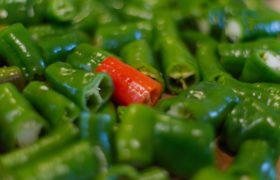(Credit for the above photo goes to Jeffery on Flickr.)
I have been waiting for Fiery Ferments by Kirsten and Christopher Shockey since I first read their previous book, Fermented Vegetables, in 2014. I had owned preservation supplies and books for a decade without using them because I was afraid of killing someone. The Shockeys were the first to convince me that I was unlikely to be the Canning Killer enabling me to take the plunge. Fermented Vegetables works as both an inspiration and a solid reference book, the kind you can look to every time you are confronted with a new excess in your CSA box. Its only drawback, in my eyes, was that I wanted more salsas.
Now comes Fiery Ferments, to perfectly satiate that need. It covers fermented hot sauces, salsas, and other spicy items such as kimchi. After a beginning introduction on how to ferment, the Shockeys treat you to a history of the chile, which wasn’t always available worldwide for use as a spice. Prior to the chile’s expansion around the globe, the Eastern hemisphere had other solutions for how to spice up a meal, from the common horseradish and peppercorn to more unfamiliar ingredients. The Shockeys provide an entire chapter of recipes using early chile precursors before several chapters devoted to chile-influenced recipes. n addition to the core of spicy ferment recipes, the book also includes two further chapters of recipes incorporating these ferments, even in drinks and desserts. This book is as comprehensive as one book on spicy fermented foods could be.
Like Fermented Vegetables, Fiery Ferments really shines in the cheerful confidence with which the Shockeys teach. “First of all: you’ve got this!” they insist at the very beginning, and over the next several pages they convince me that I do indeed have this. I feel not only comfortable that I won’t be killing anyone, I have no stress about a ferment gone “wrong” at all. They describe possible troubles that may arise and how to course correct along the way. At the end, they even provide a “fermentation doctor” section that shows images to help you diagnose your ferment and fix it. They coddle the reader a bit, assuring them that it’s ok to use special products that let the carbon dioxide escape, if it makes them feel better, or to use the simplest of items they have in their kitchen like Zip-locs. It will all work out.
They manage to provoke such confidence in me because they don’t just provide recipes and steps. They teach how fermentation works and provide a firm grounding on everything that can go wrong or right. Before you get to the first recipe, you have enough knowledge to make a hot sauce or pepper mash from any pepper combination. Before they teach how to make fun things like rhubarb kimchi, they teach how to make a universal fermented pickle. Even the recipes for using the ferments follow this pattern. Instead of a disparate grouping of things that just happen to have hot sauce in them, they focus on adaptable basics. There’s a discussion on how to make toasts and crostinis using ingredients of your choice and another on how to put together a balanced meal in a bowl. There’s not one sausage recipe but several, depending on your protein of choice. The recipes sometimes suggest which ferment to use but often instead just describe the category so that you can experiment with flavors on your own.
If I sound like a huge fan girl, it’s because I am. If you are interested in fermented veggies like sauerkraut or kimchi, I cannot recommend the work of Kirsten and Christopher Shockey highly enough.
Unfortunately, since fermentation is a long process, I did not have time to test recipes before this review like I normally do. The recipes I’ve used from Fermented Vegetables, however, have all worked out, so I trust the Shockeys.

I’m so excited to get these! I’ve been wanting to ferment more, but have had little success so far. But this book sounds like a fantastic reference.